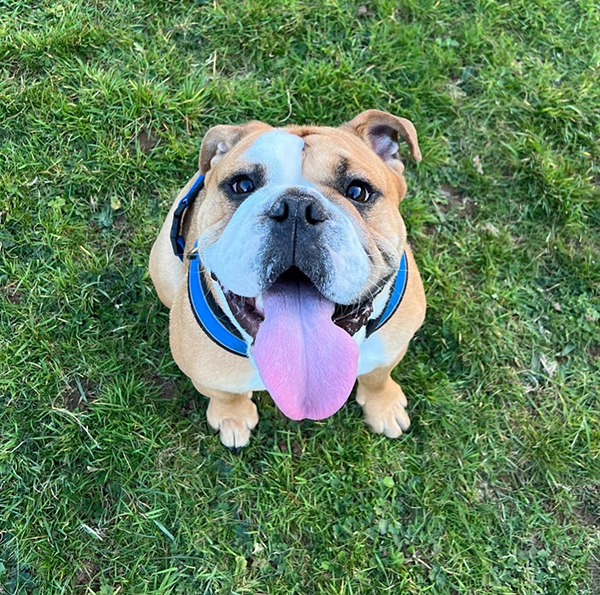Owners urged to ‘stop and think’ before buying as English bulldogs are twice as likely to have a health problem
New study from the Royal Veterinary College suggests urgent action is required to reduce many serious health issues of English Bulldogs associated with exaggerated features.

New research from the Royal Veterinary College (RVC) has revealed that English Bulldogs in the UK have lower health overall and are more likely to suffer from certain health conditions, particularly those related to being flat-faced, than other dogs. As such, the breed remains compromised by major health issues that have been recognised in Bulldogs for more than a century. The findings indicate that urgent action is required to reduce the high rate of health issues related to extreme body shape currently seen in English Bulldogs if the future of the breed is to be protected. It is hoped that the results of this research will discourage breeding and purchasing of animals with extreme conformations and instead promote a shift towards acceptance by the public of more moderate conformation with improved natural (innate) health.
The English Bulldog has risen sharply in popularity in the UK over the past decade. However, its distinctive and exaggerated short muzzle, protruding lower jaw and stocky body shape has been linked with several serious health and welfare issues, including breathing problems, skin and ear diseases and eye disorders. Sadly, many of the breed’s problematic characteristics such as a very flat face, deep facial skin folds and noisy breathing are still often perceived by many people as ‘normal’ or even ‘desirable’ novelties rather than major welfare issues.
The RVC’s VetCompass programme compared the health of random samples of 2,662 English Bulldogs and 22,039 dogs that are not English Bulldogs to extract information on all disorders recorded in each dog over a single year. Overall, English Bulldogs were found to be more than twice as likely to have one or more disorders in a single year than other dogs.
A list of the 43 most common disorders found across both groups of dogs was compiled with English Bulldogs identified to be at a higher risk of suffering from 24 out of the 43 (55.8%) disorders and a lower risk of just six out of the 43 (14%), with no difference in risk for the remainder. This demonstrates a much higher risk of health issues in English Bulldogs than in other dogs.

Other key findings included:
- The average age of English Bulldogs assessed in the study (2.7 years) was younger than for dogs that were not English Bulldogs (4.42 years). Only 9.7% of the English Bulldogs assessed in the study were aged over 8 years compared with 25.4% of dogs that were not English Bulldogs.
- Top disorders with highest risk in English Bulldog included: skin fold dermatitis (x38.1); cherry eye (x26.8); protruding lower jaw (x24.3); brachycephalic obstructive airway syndrome BOAS (x19.2); cyst between the toes (x13.0); dry eye (x12.2); rolled inward eyelids (x11.6); mange (x8.0); foot infections (x4.7); skin infection (x 3.5); wet dermatitis (x 3.5); and dermatitis (x 3.1).
- The disorders with the lowest risk in English Bulldogs included: retained baby teeth (x0.02), fatty lumps (x0.06) and dental disease (x0.23).
Despite substantial recent efforts by members of the UK Brachycephalic Working Group (BWG) to discourage extreme exaggerations, these new findings suggest further progress is needed to reduce the high rate of health issues in the overall UK population of English Bulldogs.
This new VetCompass evidence supports widespread calls to the public to follow the example of progressive breeders, and to support moving the English Bulldog away from its current extreme body shape. In the future, the English Bulldog should become recognised and loved for having a longer face, smaller head and non-wrinkled skin, representing a more moderate and healthier conformation. With an estimated 70% of UK dogs not registered with The Kennel Club and only a tiny proportion (2%) ever attending dog shows, the real power for change rests with the public who can demand and purchase only those types of dogs with moderate and healthier conformations.
Owners who already have an English Bulldog are encouraged to monitor them carefully for breed-related health issues such as eye problems, difficulty breathing and skin fold infections, and to seek veterinary advice early if worried.
Dr Dan O’Neill, lead author of the paper and Associate Professor in Companion Animal Epidemiology at the RVC said:
“Every dog deserves to be born with equal and good innate health by having a natural ability to breathe freely, blink fully, exercise easily, have healthy flat skin, mate and give birth. For breeds such as English Bulldogs where many dogs still have extreme conformations with poor innate health, the public have a huge role to play by demanding dogs with moderate and healthier conformations. Until then, prospective owners should ‘stop and think before buying a flat-faced dog’.”
Dr Alison Skipper, co-author and veterinary historian, said:
“Around 1900, some Bulldog breeders were already concerned that the exaggeration of ‘certain typical points’ was ‘intensifying predispositions to disease’ and producing ‘cripples and deformities’ with ‘a sadly shortened duration of life’. This new research provides strong evidence that modern Bulldogs remain troubled by many diseases linked to their body shapes, most of which have been recognised for more than a century. It confirms the need to follow the example of more responsible breeders who prioritise health in breeding decisions to improve the welfare of this popular and iconic breed in the future.”
Bill Lambert, Health, Welfare and Breeder Services Executive at The Kennel Club, said:
“This research, funded in part by The Kennel Club Charitable Trust, enables us and all those who care about improving Bulldog health to understand more about these complicated issues. Careful, responsible breeding can help address health problems and progress has been made to improve and protect Bulldog health by those reputable breeders and caring owners who make use of evidence-based tools, like The Kennel Club/University of Cambridge Respiratory Function Grading Scheme.
“However, as this research shows, there are increasing numbers of Bulldogs bred outside any sphere of influence and in a certain way because it is perceived to be ‘cute’, with little regard for health and welfare. A collaborative approach to tackling these issues is crucial; we must continue to work together with breeders, vets and welfare organisations to reduce and ultimately eliminate the health problems faced by brachycephalic breeds, as well as reduce mass demand for these dogs.”
Vicky Collins-Nattress, Bulldog Breed Council Health Coordinator said:
“We are fully committed to improving and protecting Bulldog health, so any new data which informs this is valuable.
“The Bulldog Breed Council Health Scheme is to encourage breeders to carry out the relevant breed-specific health tests including the University of Cambridge/Kennel Club Respiratory Function Grading Scheme; we are working with The Kennel Club on various health initiatives; and are involved in the Brachycephalic Working Group.
“Over the past 11 years that the scheme has been running we have seen a marked improvement in the health of Bulldogs bred by responsible and caring breeders who make use of the evidence-based tools available. We acknowledge that there is a large percentage of breeders that do not breed to the standard or use the Bulldog Breed Council Health Scheme. Our aim is to educate the public, with the help of The Kennel Club, to research thoroughly and buy only from the conscientious breeders that use the tools available to encourage the breeding of healthy dogs.”
Notes to Editors
*Brachycephalic obstructive airway syndrome (BOAS) refers to severe breathing problems in dogs due to combinations of various issues linked to flat faces including narrowed nostrils, elongated soft palate and collapsed larynx.
Reference
O’Neill et al. (2021) “English Bulldogs in the UK: a VetCompass study of their disorder predispositions and protections”, Canine Medicine and Genetics The full paper is available from 1am GMT Wednesday 15 June and can be accessed here: https://www.biomedcentral.com/articles/10.1186/s40575-022-00118-5 DOI: 10.1186/s40575-022-00118-5
For media enquiries, please contact:
- Jasmin De Vivo jasmin.devivo@plmr.co.uk or rvc@plmr.co.uk
- Press Line: 0800 368 9520
About the RVC
- The Royal Veterinary College (RVC) is the UK's largest and longest established independent veterinary school and is a Member Institution of the University of London.
- It is one of the few veterinary schools in the world that hold accreditations from the RCVS in the UK (with reciprocal recognition from the AVBC for Australasia, the VCI for Ireland and the SAVC for South Africa), the EAEVE in the EU, and the AVMA in the USA and Canada.
- The RVC is ranked as the top veterinary school in the world in line QS World University Rankings by subject, 2022.
- The RVC offers undergraduate and postgraduate programmes in veterinary medicine, veterinary nursing and biological sciences.
- A research led institution with 79% of its research rated as internationally excellent or world class in the Research Excellence Framework 2014.
- The RVC provides animal owners and the veterinary profession with access to expert veterinary care and advice through its teaching hospitals and first opinion practices in London and Hertfordshire.


